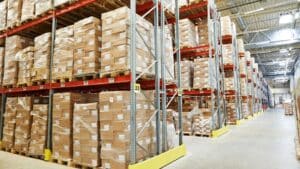Warehouses and storage facilities are prone to pest infestations. Pests like rodents, insects, and birds find warehouses ideal due to the abundance of food, water, and shelter. Ignoring pest control in these areas can lead to damaged goods, health risks, and financial losses.
Understanding the importance of pest control for warehouses and storage facilities is the first step. Pests can compromise the quality of stored items, cause structural damage, and pose serious health hazards. Effective pest control ensures a safe and healthy environment for both workers and stored products. This guide will help you understand how to identify pest problems, implement prevention strategies, and monitor for pests.
Identifying Pest Problems
Identifying pest problems early can save you from bigger issues later. Pests in warehouses can go unnoticed until they cause significant damage. Knowing the signs of pest infestations is crucial. Common signs include droppings, gnaw marks, nesting materials, and unusual smells. For example, rodent droppings are often found near food sources, while gnaw marks can appear on packaging and structures.
Different pests pose different threats. Rodents like rats and mice can chew through electrical wires, causing fire hazards. Insects such as ants, cockroaches, and beetles can contaminate food products and spread diseases. Birds, particularly pigeons, can cause damage with their droppings, which are acidic and can erode building materials.
Health and safety risks are also a major concern. Pests can spread diseases like Salmonella, E. coli, and Hantavirus. These risks make it vital to address pest problems promptly and effectively.
Prevention Strategies
Prevention is the best approach to pest control. By making your warehouse less attractive to pests, you can avoid infestations altogether. One of the first steps is structural maintenance and repairs. Seal cracks and holes in walls, floors, and around doors and windows. Install door sweeps and weather stripping to prevent pests from entering.
Sanitation and cleanliness are also key. Regularly clean storage areas, remove trash, and ensure that food and waste are properly disposed of. Pests are attracted to food and water sources, so eliminating these will make your warehouse less inviting. Clean up spills immediately and keep food storage areas tidy.
Proper storage techniques can also help. Store goods off the floor and away from walls to make it easier to spot and clean around potential hiding spots. Use airtight containers for food products to prevent pests from accessing them. Rotate stock regularly to ensure older items are used first, reducing the chance of pests settling in undisturbed areas.
Employee training and awareness are essential for a successful prevention strategy. Train staff to recognize signs of pest activity and to report any sightings immediately. Encourage them to maintain cleanliness in their work areas and to follow proper storage practices. Employees who understand the importance of pest control are more likely to contribute to a pest-free environment.
Monitoring and Detection
Effective pest control requires regular monitoring and detection. This means conducting routine inspections of your warehouse to spot any signs of pests. Look for droppings, gnaw marks, and nesting materials, and pay attention to unusual smells or sounds. Regular inspections help catch problems early, before they become severe.
Using monitoring devices can also aid in early detection. Traps and bait stations are common tools for monitoring rodent activity. Sticky traps and pheromone traps can help detect insects. Place these devices in areas where pests are likely to travel, such as along walls, near entry points, and around food storage areas. Regularly check and maintain these devices to ensure they are effective.
Pest identification is another crucial step. Identifying the type of pest you’re dealing with helps determine the most effective control methods. Different pests require different treatments, so knowing what you’re up against is important. For example, rodent control methods differ significantly from insect control methods.
Encourage employees to report any signs of pest activity immediately. Having a system in place for reporting and responding to pest sightings ensures that problems are addressed quickly. This can include a logbook for recording sightings or a designated person to handle pest control issues.
Integrated Pest Management (IPM) Approach
Integrated Pest Management, or IPM, is a smart way to handle pests. It focuses on long-term solutions and less on just spraying chemicals. IPM is about being proactive rather than reactive. This means you try to prevent pest problems before they start. Here’s how it works:
First, you inspect your warehouse. Look for any signs of pests, like droppings or nests. Check the usual hiding spots, such as corners, under pallets, and around food storage areas. Next, identify the pests you find. Knowing what pests you’re dealing with helps you choose the right treatment. Is it rodents? Cockroaches? Each type needs a different approach.
Monitoring is the next step. Keep an eye on pest activity using traps and sensors. This helps you see where pests are coming from and how many there are. Regularly checking traps and logs helps you spot problems early.
The action comes next. Based on what you found, take steps to control the pests. This might mean setting more traps, sealing entry points, or improving cleaning routines. Finally, evaluate your efforts. Did the pest problem go away? If not, tweak your plan and try again.
The IPM approach is great for warehouses because it’s thorough and sustainable. It helps reduce pest problems over time and often uses fewer chemicals, which is better for everyone’s health.
Pest Control Methods
There are many ways to control pests in your warehouse. Each method has its pros and cons. Let’s go over some of the common ones:
Non-Chemical Methods:
These are often the first line of defense. They include traps, exclusion techniques, and physical barriers. Traps are useful for catching rodents and insects. You can use snap traps, glue traps, or live traps depending on the pest. Exclusion techniques involve sealing cracks and gaps to prevent pests from entering. Physical barriers, like mesh screens, can keep birds and larger pests out.
Chemical Methods:
Sometimes, you need chemicals to control a serious pest problem. Pesticides and fumigation are common chemical methods. Pesticides can be sprayed, dusted, or applied as bait. They are effective but should be used carefully to avoid harming people or contaminating products. Fumigation is a more drastic measure, often used for severe infestations. It involves sealing the area and filling it with a gas that kills pests. This method requires professional handling due to its risks.
Biological Control:
This method uses natural predators or parasites to control pests. For example, certain types of beetles can control other insect pests. This method is eco-friendly and can be very effective, but it needs to be managed carefully to ensure it doesn’t upset the balance of your warehouse ecosystem.
Each method has its place in a pest control plan. Often, a combination of methods works best. This approach ensures that you cover all your bases and deal with pests in the most effective way.
Rodent Control
Rodents are a big problem in warehouses. They can damage goods, chew through wires, and spread diseases. Here’s how to handle them:
First, know your enemy. Common rodents in warehouses are mice and rats. Mice are small and can squeeze through tiny openings. Rats are larger and often need more food and water.
To prevent rodents, start with sealing entry points. Check doors, windows, and walls for gaps and cracks. Use metal or concrete to seal them because rodents can chew through wood and plastic. Keep food storage areas clean and tidy. Rodents are attracted to food scraps and spills, so regular cleaning is essential.
Next, set traps. Place snap traps or glue boards along walls and near entry points. Check and empty them regularly. Bait stations with rodenticides can also be effective but should be used carefully to avoid accidental poisoning.
Rodent-proofing your warehouse also means managing the outside area. Keep the area around the building clean and free of debris. Trim back vegetation and store trash in sealed bins away from the building.
Rodent control is an ongoing process. Regular inspections, good sanitation, and effective trapping help keep rodent populations under control. Stay vigilant, and you can keep these pesky critters out of your warehouse.
Insect Control
Insects can be a nuisance in warehouses. They can spoil food products and spread diseases. Here’s how to deal with common insect pests:
First, identify the type of insects you’re dealing with. Common warehouse pests include ants, cockroaches, beetles, and moths. Each type requires a different control method.
Prevention:
Start with good sanitation practices. Keep storage areas clean and dry. Fix any leaks and avoid letting water pool. Store food products in airtight containers and keep them off the floor. Regularly rotate stock to prevent pests from settling in undisturbed areas.
Control Methods:
Use insecticides carefully. Spray areas where insects are likely to hide, like cracks, crevices, and behind equipment. Insect baits can also be effective, especially for ants and cockroaches. Place baits in areas where you’ve seen insect activity and replace them regularly.
Traps:
Sticky traps and pheromone traps are useful for monitoring and controlling insect populations. Place these traps in areas where insects are likely to travel, such as near entry points and around food storage areas. Check and replace traps regularly to keep them effective.
Bird Control
Birds might not seem like a big problem, but they can cause serious issues in warehouses. Pigeons and sparrows are the most common offenders. Their droppings can damage goods and equipment, and they can carry diseases. Here’s how to keep birds out:
Prevention Tips:
Start by making your warehouse less inviting to birds. Remove food and water sources. Keep trash bins covered and clean up any spills promptly. Ensure doors and windows are closed when not in use.
Exclusion Techniques:
Physical barriers are very effective for bird control. Install netting around open areas to keep birds from getting in. Use spikes on ledges and beams where birds like to perch. These methods make it difficult for birds to land and nest.
Deterrents:
Visual and auditory deterrents can help scare birds away. Reflective tapes, balloons, and fake predators (like owls) can make birds think twice about settling in your warehouse. Sound devices that mimic predator calls or distress signals can also be effective.
Control Methods:
If birds have already nested, you might need to use traps. Live traps can capture birds humanely for relocation. Always follow local regulations when handling bird problems, as some species are protected.
Working with Professional Pest Control Services
Sometimes, you need the help of experts. Professional pest control services can provide thorough, effective treatments that go beyond what you can do on your own. Here’s why it’s a good idea to work with the pros:
Benefits:
Professional pest control services have the experience and tools to handle all kinds of pest problems. They can identify pests accurately and choose the best treatment methods. They also follow safety protocols to ensure that treatments are safe for your employees and goods.
What to Expect:
When you hire a pest control company, they will start with an inspection to assess the situation. They will then create a customized pest control plan for your warehouse. This plan might include regular inspections, treatments, and monitoring.
Choosing the Right Company:
Look for a pest control company with good reviews and a proven track record. Check their credentials and make sure they are licensed and insured. Ask about their experience with warehouses and storage facilities specifically.
Legal and Regulatory Compliance
Pest control isn’t just about keeping your warehouse clean and safe. It’s also about following the law. There are regulations and standards in place to ensure that pest control is done safely and effectively. Here’s what you need to know:
Relevant Regulations:
Different regions have different regulations for pest control. These can include rules about pesticide use, disposal, and safety protocols. Make sure you are familiar with the regulations in your area.
Compliance:
Following these regulations is important for safety and for your reputation. Non-compliance can result in fines, legal issues, and damage to your business’s reputation. Always work with pest control professionals who understand and follow these regulations.
Importance of Compliance:
Staying compliant shows that you care about safety and quality. It protects your employees, your products, and your business. It also helps build trust with customers and partners.
Managing pests in warehouses and storage facilities is crucial for maintaining a safe, clean, and efficient operation. By identifying pest problems early, implementing preventive measures, and working with professional pest control services, you can keep your warehouse pest-free.







